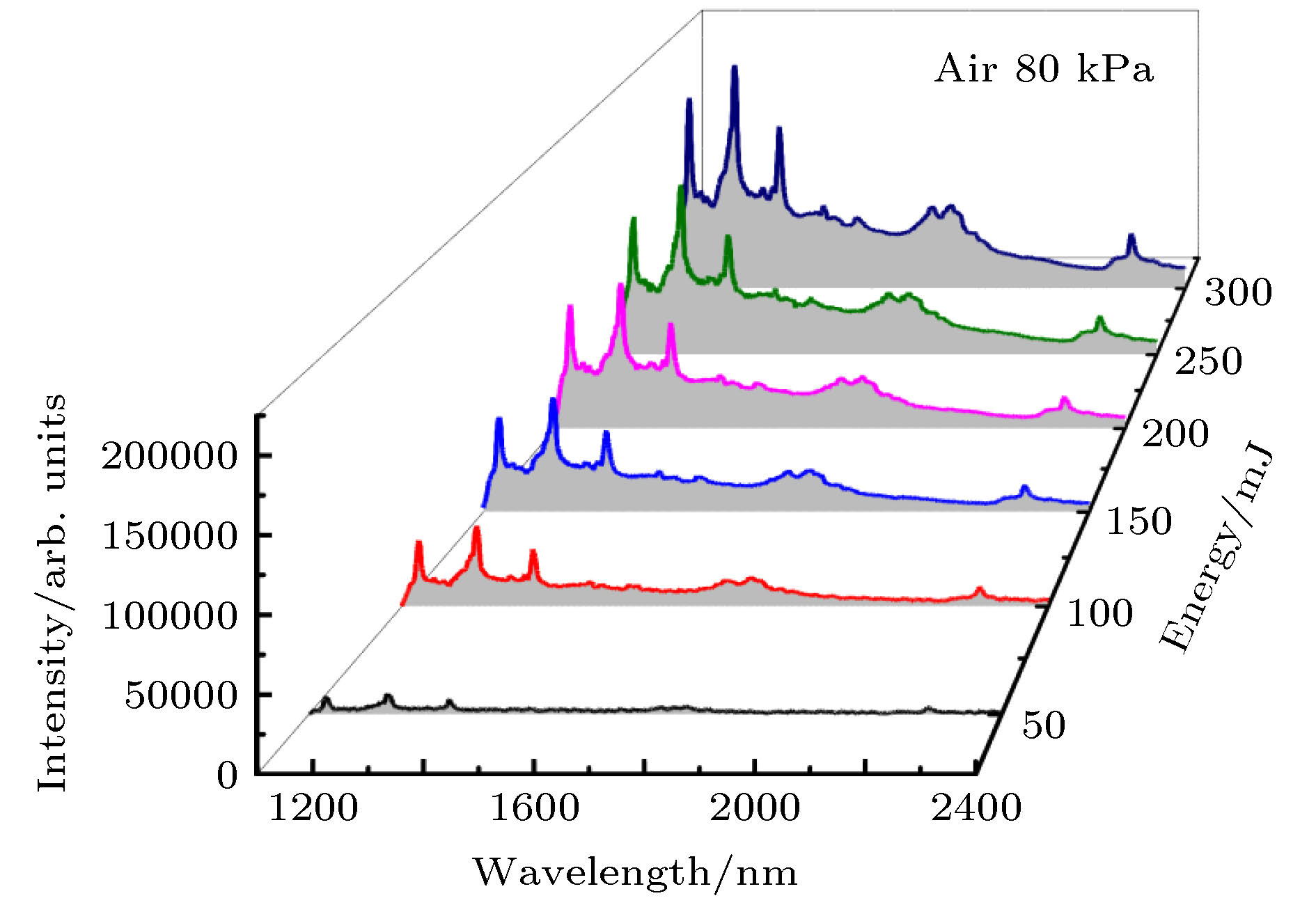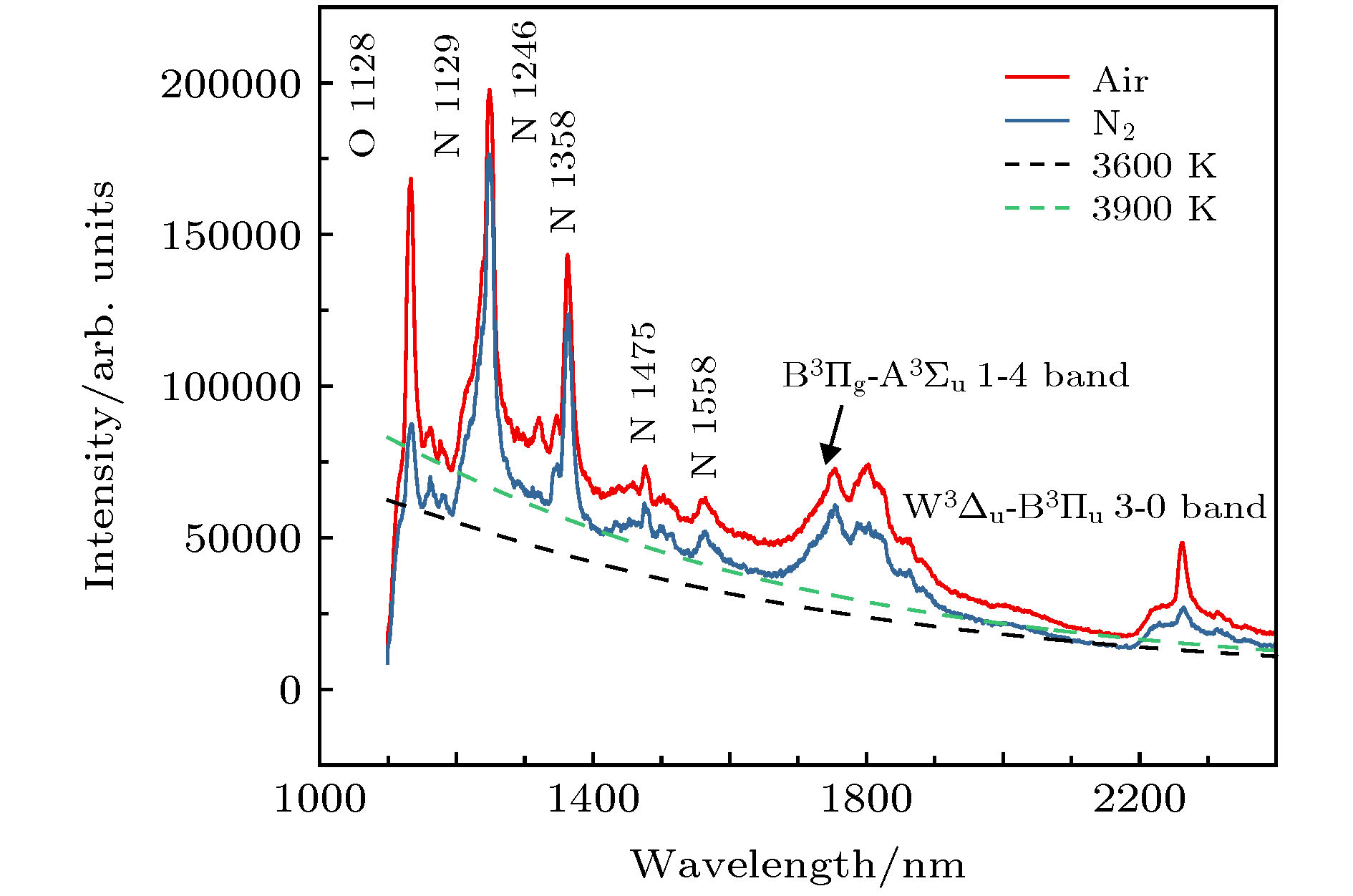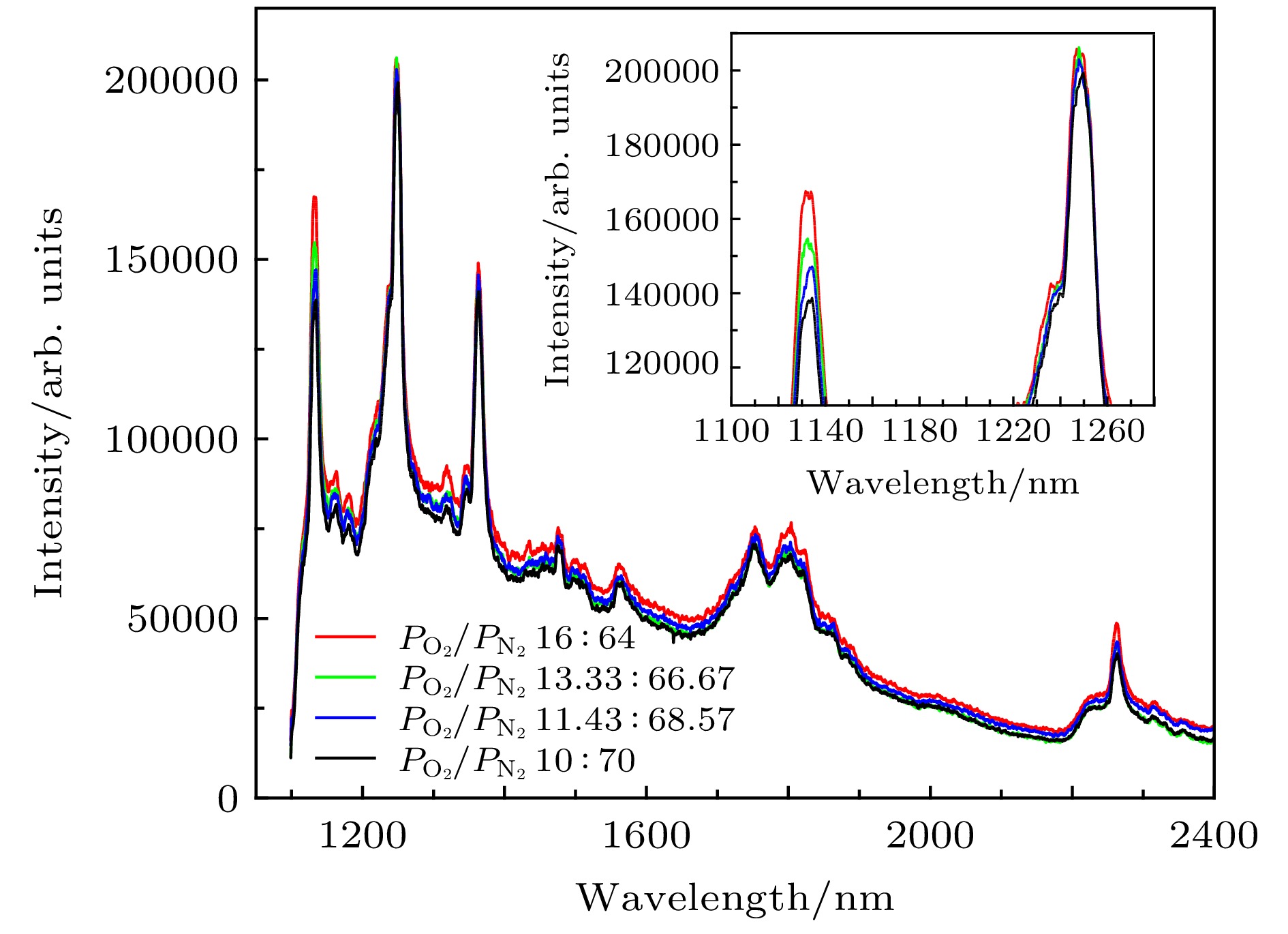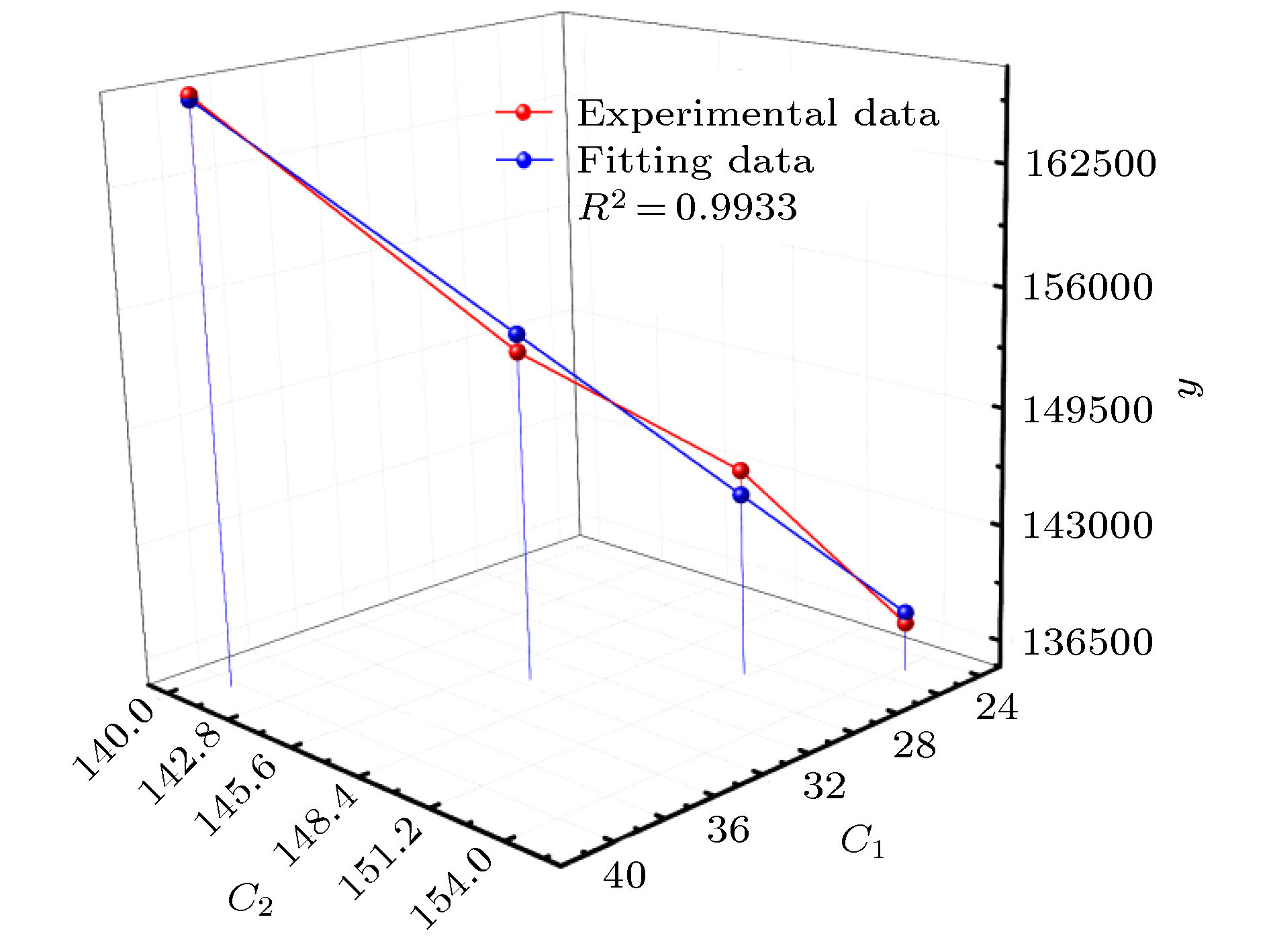-
开展纳秒激光诱导空气等离子体近红外辐射特性的实验研究, 对波长为532 nm的脉冲ns激光诱导产生的空气等离子体的近红外光谱进行测量. 结果表明: 空气等离子体的近红外辐射在光谱范围为1100—2400 nm内由连续谱和线状谱组成, 光谱指认表明线谱主要来源于N, O原子的中性原子谱和氮分子的振动光谱. 通过对连续谱的分析得知, 黑体辐射是连续辐射的主要来源. 空气中波长1128 nm附近的辐射, 可能是N和O中性原子谱的贡献. 保持真空腔内气压不变, 改变腔内氮气和氧气气体组分含量, 分析测得的红外光谱数据, 可知混合气体中氧气和氮气含量变化只对波长为1128 nm附近的辐射有影响. 利用二元线性回归分析对数据进行分析后得知, 氧气对波长为1128 nm附近的辐射贡献较大. 最后从电离难易的角度分析造成这一结果的原因.The near infrared emission from laser induced air plasma has been investigated in a range of 1100–2400 nm. The infrared spectra of air plasma consist of linear spectral and continuum radiation. Most of the spectral features observed are identified, including atomic lines of O I and N I and molecular bands of N2. The spectra show trace of blackbody background emission and the plasma temperature is estimated from Planck law. We find that the continuum radiation is mainly origins mainly from the blackbody emission of plasma. There is a limitation of plasma temperature estimation by using Boltzmann method. For example, the local thermodynamic equilibrium must be satisfied, and the trend of change in plasma temperature can be estimated within a few microseconds after the laser shot. In this paper, the plasma temperature in 15 μs after laser irradiation is estimated from the Planck law, and the temperature of air plasma is estimated to be about 3900 K, which can compensate for the shortcomings of Boltzmann method. It is found that the neutral atomic spectra of N and O both may contribute to the radiation of the air plasma at 1128 nm. Then we keep the air pressure in the vacuum chamber at 80 kPa, and change the nitrogen and oxygen content in the chamber. The infrared spectrum data show that the oxygen content in the mixed gas only affect the radiation of 1128 nm wavelength. The binary linear regression analysis shows that oxygen contributes much to the radiation of 1128 nm wavelength. This can be explained by the difference in ionization potential between molecule O2 and N2. The infrared radiation intensities of the air plasma at 1128 nm under 20−80 kPa are obtained, and they are compared with the calculated results obtained with the fitting formula. The predicted value is very close to the experimental value and the relative error is negligibly at the pressure of 30−80 kPa. The study of the characteristics of infrared emission from laser induced plasma is of great significance for understanding and using the physical mechanisms of laser-matter interaction.
-
Keywords:
- nanosecond laser /
- air plasma /
- near infrared emission
[1] Murnane M M, Kapteyn H C, Rosen M D, Falcone R W 1991 Science 251 531
 Google Scholar
Google Scholar
[2] Knudtson J T, Green W B, Sutton D G 1987 J. Appl. Phys. 61 4771
 Google Scholar
Google Scholar
[3] Civis S, Ferus M, Kubelík P, Jelinek P, Chernov V E 2012 Astron. Astrophys. 541 A125
 Google Scholar
Google Scholar
[4] Zhong H, Karpowicz N, Zhang X C 2006 Appl. Phys. Lett. 88 261103
 Google Scholar
Google Scholar
[5] Aspiotis J A, Barbieri N, Bernath R, Brown C G, Richardson M, Cooper B Y 2006 Proc. SPIE-Int. Soc. Opt. Eng. 6219 621908
[6] Forestier B, Houard A, Durand M, Andre Y B, Prade B, Dauvignac J Y, Perret F, Pichot C, Pellet M, Mysyrowicz A 2010 Appl. Phys. Lett. 96 141111
 Google Scholar
Google Scholar
[7] Wu B, Kumar A 2007 J. Vac. Sci. Technol., B: Microelectron. Nanometer Struct. 25 1743
 Google Scholar
Google Scholar
[8] Rusak D A, Castle B C, Smith B W, Winefordner J D 1997 Crit. Rev. Anal. Chem. 27 257
 Google Scholar
Google Scholar
[9] 张立文, 林晨, 辛立, 高军毅 2008 强激光与粒子束 20 1603
Zhang L W, Chen L, Li X, Gao J Y 2008 High Power Laser Part. Beams 20 1603
[10] Thomson M D, Kreß M, Loffler T, Roskos H G 2007 Laser Photonics Rev. 1 349
 Google Scholar
Google Scholar
[11] Nakajima H, Shimada Y, Somekawa T, Fujita M, Tanaka K A 2009 IEEE Geosci. Remote Sens. Lett. 6 718
 Google Scholar
Google Scholar
[12] Giacconi R 2003 Rev. Mod. Phys. 75 995
 Google Scholar
Google Scholar
[13] Brackett F S 1922 Astrophys. J. 56 154
 Google Scholar
Google Scholar
[14] Pfund A H 1924 J. Opt. Soc. Am. Rev. Sci. Instrum. 9 193
 Google Scholar
Google Scholar
[15] Steffey W W 1926 IEEE Aerosp. Electron. Syst. Mag. 21 55
[16] Meggers W F, De- Bruin T L, Humphreys C J 1929 Science 69 406
[17] Saum K A, Benesch W M 1970 Appl. Opt. 9 1419
 Google Scholar
Google Scholar
[18] Saum K A, Benesch W M 1970 Appl. Opt. 9 195
 Google Scholar
Google Scholar
[19] Tanaka H, Akinaga K, Takahashi A, Okada T 2004 Appl. Phys. A 79 1493
 Google Scholar
Google Scholar
[20] Adamson A W, Cimolino M C 1984 J. Phys. Chem. B 88 488
 Google Scholar
Google Scholar
[21] El-RabiiH, Victorov S B, Yalin A P 2009 J. Phys. D: Appl. Phys. 42 075203
 Google Scholar
Google Scholar
[22] Harilal S S, Skrodzki P J, Miloshevsky A, Brumfield B E, Phillips M C, Miloshevsky G 2017 Phys. Plasmas 24 063304
 Google Scholar
Google Scholar
[23] Radziemski L J, Cremers D A, Bostian M, Chinni R C, Navarro-northrup C 2007 Appl. Spectrosc. 61 1141
 Google Scholar
Google Scholar
[24] Lofthus A, Krupenie P H 2009 J. Phys. Chem. Ref. Data 6 113
[25] Smith D, Adams N G, Miller T M 1978 J. Chem. Phys. 69 308318
[26] Shneider M N, Zheltikovs A M, Miles R B 2011 Phys. Plasmas. 18 063509
 Google Scholar
Google Scholar
-
表 1 氮原子和氧原子的红外光谱指认
Table 1. Identification of the observed emission lines of NI and OI
Species λ/nm Aki/s–1 Lower state Upper state Term symbol J Term symbol J O I 1128.6317 2.32 × 107 2s22p3(4S0)3p 3P 1 2s22p3(4S0)3d 3D° 2 O I 1128.6406 1.29 × 107 2s22p3(4S0)3p 3P 1 2s22p3(4S0)3d 3D° 1 O I 1128.6914 3.09 × 107 2s22p3(4S0)3p 3P 2 2s22p3(4S0)3d 3D° 3 O I 1128.7029 7.74 × 106 2s22p3(4S0)3p 3P 2 2s22p3(4S0)3d 3D° 2 O I 1128.7318 1.72 × 107 2s22p3(4S0)3p 3P 0 2s22p3(4S0)3d 3D° 1 O I 1129.5103 5.34 × 106 2s22p3(4S0)3p 5P 1 2s22p3(4S0)4s 5S° 2 O I 1129.7682 8.90 × 106 2s22p3(4S0)3p 5P 2 2s22p3(4S0)4s 5S° 2 O I 1130.2378 1.25 × 107 2s22p3(4S0)3p 5P 3 2s22p3(4S0)3d 5S° 2 N I 1129.167 1.20 × 107 2s22p2(3P)3p 4D° 7/2 2s22p2(3P)4s 4P 5/2 N I 1131.389 1.00 × 107 2s22p2(3P)3p 4D° 5/2 2s22p2(3P)4s 4P 3/2 N I 1132.318 8.19 × 106 2s22p2(3P)3p 4D° 3/2 2s22p2(3P)4s 4P 1/2 N I 1246.1253 1.82 × 107 2s22p2(3P)3p 2D° 3/2 2s22p2(3P)3d 2F 5/2 N I 1246.9615 2.18 × 107 2s22p2(3P)3p 2D° 5/2 2s22p2(3P)3d 2F 7/2 N I 1358.1323 5.76 × 106 2s22p2(3P)3 s 2P 3/2 2s22p2(3P)3p 2S° 1/2 N I 1358.7710 6.31 × 106 2s22p2(3P)3p 2D° 5/2 2s22p2(3P)4s 2P 3/2 N I 1360.227 1.07 × 107 2s22p2(3P)3p 2P° 1/2 2s22p2(3P)3d 2D 3/2 N I 1362.418 1.33 × 107 2s22p2(3P)3p 2P° 3/2 2s22p2(3P)3d 2D 5/2 N I 1475.7073 1.06 × 106 2s22p4 4P 5/2 2s22p2(3P)3p 4D° 7/2 N I 1558.2287 6.5 × 106 2s22p2(3P)3p 2P° 3/2 2s22p2(3P)4s 2P 3/2 表 2 波长1128 nm红外光谱强度拟合公式预测值与实验值对比
Table 2. Comparison between predicted value and experimental value of the intensity of 1128 nm.
气体 气压/kPa 预测值 实验值 相对误差/% Air 80 169842 166903 1.76 70 148612 153136 2.95 60 127382 140317 9.21 50 106151 117673 9.79 40 84921 88516 4.06 30 63691 56575 12.56 20 42460 27964 51.80 -
[1] Murnane M M, Kapteyn H C, Rosen M D, Falcone R W 1991 Science 251 531
 Google Scholar
Google Scholar
[2] Knudtson J T, Green W B, Sutton D G 1987 J. Appl. Phys. 61 4771
 Google Scholar
Google Scholar
[3] Civis S, Ferus M, Kubelík P, Jelinek P, Chernov V E 2012 Astron. Astrophys. 541 A125
 Google Scholar
Google Scholar
[4] Zhong H, Karpowicz N, Zhang X C 2006 Appl. Phys. Lett. 88 261103
 Google Scholar
Google Scholar
[5] Aspiotis J A, Barbieri N, Bernath R, Brown C G, Richardson M, Cooper B Y 2006 Proc. SPIE-Int. Soc. Opt. Eng. 6219 621908
[6] Forestier B, Houard A, Durand M, Andre Y B, Prade B, Dauvignac J Y, Perret F, Pichot C, Pellet M, Mysyrowicz A 2010 Appl. Phys. Lett. 96 141111
 Google Scholar
Google Scholar
[7] Wu B, Kumar A 2007 J. Vac. Sci. Technol., B: Microelectron. Nanometer Struct. 25 1743
 Google Scholar
Google Scholar
[8] Rusak D A, Castle B C, Smith B W, Winefordner J D 1997 Crit. Rev. Anal. Chem. 27 257
 Google Scholar
Google Scholar
[9] 张立文, 林晨, 辛立, 高军毅 2008 强激光与粒子束 20 1603
Zhang L W, Chen L, Li X, Gao J Y 2008 High Power Laser Part. Beams 20 1603
[10] Thomson M D, Kreß M, Loffler T, Roskos H G 2007 Laser Photonics Rev. 1 349
 Google Scholar
Google Scholar
[11] Nakajima H, Shimada Y, Somekawa T, Fujita M, Tanaka K A 2009 IEEE Geosci. Remote Sens. Lett. 6 718
 Google Scholar
Google Scholar
[12] Giacconi R 2003 Rev. Mod. Phys. 75 995
 Google Scholar
Google Scholar
[13] Brackett F S 1922 Astrophys. J. 56 154
 Google Scholar
Google Scholar
[14] Pfund A H 1924 J. Opt. Soc. Am. Rev. Sci. Instrum. 9 193
 Google Scholar
Google Scholar
[15] Steffey W W 1926 IEEE Aerosp. Electron. Syst. Mag. 21 55
[16] Meggers W F, De- Bruin T L, Humphreys C J 1929 Science 69 406
[17] Saum K A, Benesch W M 1970 Appl. Opt. 9 1419
 Google Scholar
Google Scholar
[18] Saum K A, Benesch W M 1970 Appl. Opt. 9 195
 Google Scholar
Google Scholar
[19] Tanaka H, Akinaga K, Takahashi A, Okada T 2004 Appl. Phys. A 79 1493
 Google Scholar
Google Scholar
[20] Adamson A W, Cimolino M C 1984 J. Phys. Chem. B 88 488
 Google Scholar
Google Scholar
[21] El-RabiiH, Victorov S B, Yalin A P 2009 J. Phys. D: Appl. Phys. 42 075203
 Google Scholar
Google Scholar
[22] Harilal S S, Skrodzki P J, Miloshevsky A, Brumfield B E, Phillips M C, Miloshevsky G 2017 Phys. Plasmas 24 063304
 Google Scholar
Google Scholar
[23] Radziemski L J, Cremers D A, Bostian M, Chinni R C, Navarro-northrup C 2007 Appl. Spectrosc. 61 1141
 Google Scholar
Google Scholar
[24] Lofthus A, Krupenie P H 2009 J. Phys. Chem. Ref. Data 6 113
[25] Smith D, Adams N G, Miller T M 1978 J. Chem. Phys. 69 308318
[26] Shneider M N, Zheltikovs A M, Miles R B 2011 Phys. Plasmas. 18 063509
 Google Scholar
Google Scholar
计量
- 文章访问数: 14634
- PDF下载量: 114
- 被引次数: 0














 下载:
下载:




